





Many years ago, when I was only a child, I fell in love with the beautiful touch-me-not. These beautiful plants fell, somehow, in disgrace, in our city of Bucharest and they disappeared from the floral designs. It was only many years later that I saw them again and my heart sang with joy and happiness!
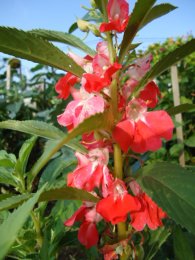 I love all plants, but, like anyone else, I have my favorites. Even so, only some of them make me so excited that I feel like falling in love with them. Impatiens balsamina, also called garden balsam, rose balsam, lady slipper, is one of these plants. It is an annual, outdoor plant in the Impatiens genus, Balsaminaceae family, originated from southern Asia, in India and Burma and related with the
I love all plants, but, like anyone else, I have my favorites. Even so, only some of them make me so excited that I feel like falling in love with them. Impatiens balsamina, also called garden balsam, rose balsam, lady slipper, is one of these plants. It is an annual, outdoor plant in the Impatiens genus, Balsaminaceae family, originated from southern Asia, in India and Burma and related with the
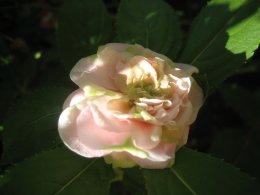 potted impatiens, Impatiens walleriana. Leaves are lanceolate, light green, spirally arranged on the thick, but soft stem, which can grow up to 31 inches (80cm). Simple or double cup-shaped flowers are 2 inches (5cm), colored in red, white, pink, magenta, fuchsia, mauve, lilac, circularly arranged on the stem; each growing from the base of a leaf. Each flower has both male and female organs (hermaphrodite) and are pollinated by insects. [1] Seedlings are typically popping out in May around here, and start blooming in late June. They stop blooming at first frost.
potted impatiens, Impatiens walleriana. Leaves are lanceolate, light green, spirally arranged on the thick, but soft stem, which can grow up to 31 inches (80cm). Simple or double cup-shaped flowers are 2 inches (5cm), colored in red, white, pink, magenta, fuchsia, mauve, lilac, circularly arranged on the stem; each growing from the base of a leaf. Each flower has both male and female organs (hermaphrodite) and are pollinated by insects. [1] Seedlings are typically popping out in May around here, and start blooming in late June. They stop blooming at first frost.
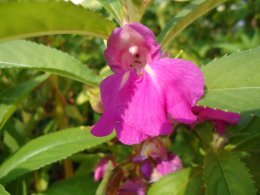
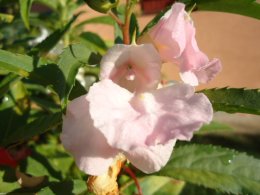
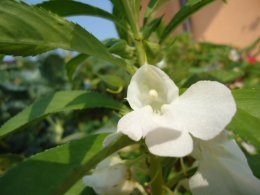
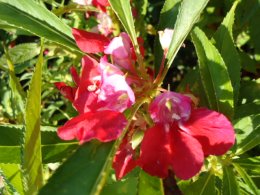
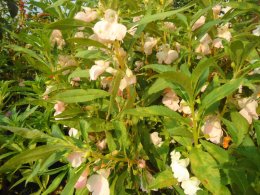 Seed pods are characteristic to this genus, bursting open at the slightest touch when ripe and spreading all seeds around - that's why they were named with the Latin Impatiens and with the common names of Touch-Me-Not or Snapweed. When the ripe seed pods are touched, they instantly split and curl, spreading the seeds all over. This mechanism is called explosive dehiscence. For that particular reason, these plants can be invasive, yet I consider them good invaders! The seed pods don't dry at maturity, like other seed pods, just turn into a paler green to yellowish. The ripe seeds are brown. If they are still pale green, they aren't good for propagation. I like balsams' self-seeding because I don't have to sow their seeds anymore.
Seed pods are characteristic to this genus, bursting open at the slightest touch when ripe and spreading all seeds around - that's why they were named with the Latin Impatiens and with the common names of Touch-Me-Not or Snapweed. When the ripe seed pods are touched, they instantly split and curl, spreading the seeds all over. This mechanism is called explosive dehiscence. For that particular reason, these plants can be invasive, yet I consider them good invaders! The seed pods don't dry at maturity, like other seed pods, just turn into a paler green to yellowish. The ripe seeds are brown. If they are still pale green, they aren't good for propagation. I like balsams' self-seeding because I don't have to sow their seeds anymore.
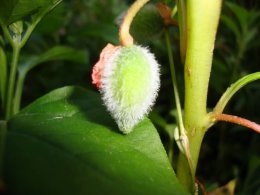
When I was a child, rose balsams were everywhere, in my grandfather's garden, in our block's garden, in the park, in the flower beds along the streets. In my family, balsams were known as "small peaches" - the name coming from the hairy seed pods, I suppose. Sometime along the years, the interest for balsams was lost, other plants being preferred - those which were thriving more and probably needed less care, like the Impatiens walleriana, also called busy Lizzie - mostly grown indoors. Touch-me-nots need more watering during the hot summer days, otherwise they wither and look poorly; yet, they don't like overwatering, which makes them rot. They seem to thrive well in partial shade and shade.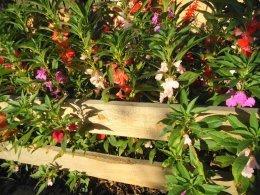 About ten years ago, I was on vacation on the Black Sea Coast, in the Saturn resort. I admired all flowers blooming everywhere in that little town and, obviously, I took many seeds from all. One evening, when we were visiting some friends at another hotel, I had the pleasant surprise to see two beautiful rows of balsams, on each side of the alley going to the hotel's entrance. They were so crowded, yet well-grown, with many colorful flowers. The sight was amazing! Since it was in August, many of the plants had ripe seed pods, so I took lots of seeds, of each color, which I remembered from my childhood. I told myself that I have to grow such colorful rows in my block's garden too! I couldn't wait for the spring to come so I could start my colorful rose balsam rows.
About ten years ago, I was on vacation on the Black Sea Coast, in the Saturn resort. I admired all flowers blooming everywhere in that little town and, obviously, I took many seeds from all. One evening, when we were visiting some friends at another hotel, I had the pleasant surprise to see two beautiful rows of balsams, on each side of the alley going to the hotel's entrance. They were so crowded, yet well-grown, with many colorful flowers. The sight was amazing! Since it was in August, many of the plants had ripe seed pods, so I took lots of seeds, of each color, which I remembered from my childhood. I told myself that I have to grow such colorful rows in my block's garden too! I couldn't wait for the spring to come so I could start my colorful rose balsam rows.
The following spring I sowed the touch-me-not seeds in my block's garden, in the same way I saw at that hotel, on each side of our alley. I could hardly wait to see the colorful rows of balsams! Coming summer - and all following summers - I enjoyed the 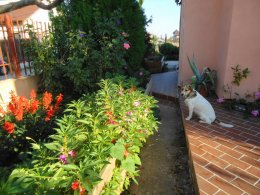 snapweeds, as all my neighbors did. Or, so I thought, until I had an unexpected dialogue with one of the neighbors. He had a German Shepherd who used that area to relieve herself, as they were close to the entrance. I asked my neighbor to hold the dog until they were farther away, so she wouldn't ruin the balsams, which I was so carefully taking care of, so that everyone can enjoy their blooms. He was nice and agreed to what I asked him, but he told me something I wasn't expecting: he didn't even notice those plants! I was disappointed, of course, yet, other neighbors noticed it, as well as all other plants in the garden. They always admired the blooms and that was enough for me.
snapweeds, as all my neighbors did. Or, so I thought, until I had an unexpected dialogue with one of the neighbors. He had a German Shepherd who used that area to relieve herself, as they were close to the entrance. I asked my neighbor to hold the dog until they were farther away, so she wouldn't ruin the balsams, which I was so carefully taking care of, so that everyone can enjoy their blooms. He was nice and agreed to what I asked him, but he told me something I wasn't expecting: he didn't even notice those plants! I was disappointed, of course, yet, other neighbors noticed it, as well as all other plants in the garden. They always admired the blooms and that was enough for me.
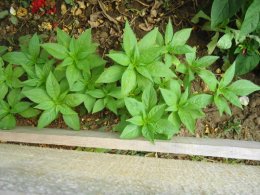 When we moved in our actual house, I took lots of balsam seeds with me, as well as other seeds of the plants I was growing at the block. Every summer I have rows of colorful rose balsams in my garden, which makes my heart sing! They re-seed every year, so I usually don't need to sow any other seeds. However, there is a special task I need to do: pick up all seed pods, otherwise I'd have only balsams in my garden! Even so, many of them are growing all over the garden and I really want to sow in rows, because I still like this arrangement. The balsam rows are amazing and so beautiful, that I admire them every time I can. They start growing in June, then start blooming by the end of the month. They can grow really tall and sometimes branch out, especially if I water them well. Sometimes, one of them rots, which makes me sad.
When we moved in our actual house, I took lots of balsam seeds with me, as well as other seeds of the plants I was growing at the block. Every summer I have rows of colorful rose balsams in my garden, which makes my heart sing! They re-seed every year, so I usually don't need to sow any other seeds. However, there is a special task I need to do: pick up all seed pods, otherwise I'd have only balsams in my garden! Even so, many of them are growing all over the garden and I really want to sow in rows, because I still like this arrangement. The balsam rows are amazing and so beautiful, that I admire them every time I can. They start growing in June, then start blooming by the end of the month. They can grow really tall and sometimes branch out, especially if I water them well. Sometimes, one of them rots, which makes me sad.
I usually alternate the Sweet William rows with the touch-me-not rows, so when the first fade away, the balsams start growing. I admire all of them and enjoy each flower - and I take many pictures! The balsams are my first priority during summer, because I suffer when I see them withered after a hot day. Because of them -or, better said, thanks to them!- I'm watching every weather forecast on TV, on every single day! Touch-me-nots are blooming all summer, until September, even October, if the summer is long. Is it any wonder this is one of my favorite plants?
[1] - http://www.pfaf.org/user/Plant.aspx?LatinName=Impatiens+balsamina
Copyright © www.100flowers.win Botanic Garden All Rights Reserved